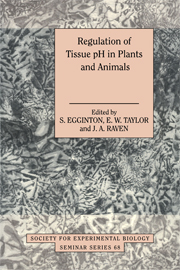Book contents
- Frontmatter
- Contents
- List of contributors
- Preface
- Measurement of intracellular pH: a comparison between ion-sensitive microelectrodes and fluorescent dyes
- pH-sensitive microelectrodes: how to use them in plant cells
- The use of nuclear magnetic resonance for examining pH in living systems
- Invasive studies of intracellular acid–base parameters: quantitative analyses during environmental and functional stress
- Lactate, H+ and ammonia transport and distribution in rainbow trout white muscle after exhaustive exercise
- Limiting factors for acid–base regulation in fish: branchial transfer capacity versus diffusive loss of acid–base relevant ions
- H+-mediated control of ion channels in guard cells of higher plants
- pH regulation of plants with CO2-concentrating mechanisms
- Intracellular pH regulation in plants under anoxia
- The role of turtle shell in acid–base buffering
- Acid–base regulation in crustaceans: the role of bicarbonate ions
- A novel role for the gut of seawater teleosts in acid–base balance
- pH and smooth muscle: regulation and functional effects
- Regulation of pH in vertebrate red blood cells
- Acid–base regulation in hibernation and aestivation
- Hepatic metabolism and pH in starvation and refeeding
- Back to basics: a plea for a fundamental reappraisal of the representation of acidity and basicity in biological solutions
- Index
H+-mediated control of ion channels in guard cells of higher plants
Published online by Cambridge University Press: 22 August 2009
- Frontmatter
- Contents
- List of contributors
- Preface
- Measurement of intracellular pH: a comparison between ion-sensitive microelectrodes and fluorescent dyes
- pH-sensitive microelectrodes: how to use them in plant cells
- The use of nuclear magnetic resonance for examining pH in living systems
- Invasive studies of intracellular acid–base parameters: quantitative analyses during environmental and functional stress
- Lactate, H+ and ammonia transport and distribution in rainbow trout white muscle after exhaustive exercise
- Limiting factors for acid–base regulation in fish: branchial transfer capacity versus diffusive loss of acid–base relevant ions
- H+-mediated control of ion channels in guard cells of higher plants
- pH regulation of plants with CO2-concentrating mechanisms
- Intracellular pH regulation in plants under anoxia
- The role of turtle shell in acid–base buffering
- Acid–base regulation in crustaceans: the role of bicarbonate ions
- A novel role for the gut of seawater teleosts in acid–base balance
- pH and smooth muscle: regulation and functional effects
- Regulation of pH in vertebrate red blood cells
- Acid–base regulation in hibernation and aestivation
- Hepatic metabolism and pH in starvation and refeeding
- Back to basics: a plea for a fundamental reappraisal of the representation of acidity and basicity in biological solutions
- Index
Summary
Introduction
Among biological systems for studying transport and signalling functions, stomatal guard cells are one of a very few highly successful cell models for higher plants. The dominance of the guard cell in this respect owes much to its unique situation and physiological function, features that have been used to considerable experimental advantage. Unlike the vast majority of cells in higher plants, guard cells lack functional plasmodesmata at maturity, and so are physically isolated from the neighbouring epidermal and mesophyll cells (Wille & Lucas, 1984; Willmer & Fricker, 1996). As a direct consequence, electrophysiological investigation of intact guard cells is possible without the complications of electrical coupling between cells. Thus, despite their comparatively small size, quantitative voltage clamp studies of guard cells have been carried out from several species, notably Nicotiana, Arabidopsis and Vicia. Furthermore, because this cell type can be isolated relatively easily, at least in the limited numbers required for such studies, guard cells have afforded virtually the only opportunity for comparisons of ion channel and other transport characteristics recorded in enzymatically isolated protoplasts and in situ (Lemtiri-Chlieh, 1996).
No less important, access into the network of regulatory processes that control guard cell membrane ion pumps and channels has been possible through the unique physiology of stomata. Guard cells are situated at the end of the transpiration stream within the plant. They surround small pores in the epidermis through which gas exchange for photosynthesis within the leaf mesophyll takes place. It is also through these pores that the bulk of water loss from the plant occurs.
- Type
- Chapter
- Information
- Regulation of Tissue pH in Plants and AnimalsA Reappraisal of Current Techniques, pp. 155 - 176Publisher: Cambridge University PressPrint publication year: 1999
- 1
- Cited by



